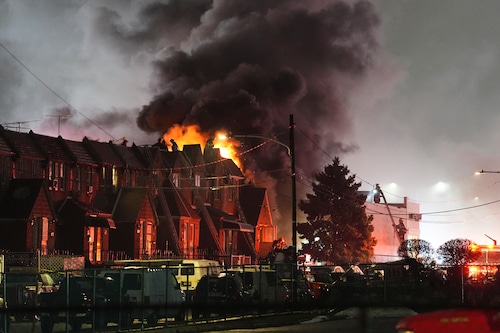By Rob Tornoe, Nick Vadala, Erin McCarthy, and Sean Collins Walsh, The Philadelphia Inquirer (TNS)
The city of Philadelphia Even though there are still unanswered questions about what caused the crash and who will foot the bill for recovery efforts, officials announced Monday that Friday’s tragic plane crash in Northeast Philadelphia had damaged four homes and affected over 300.
To reassure the neighborhood around Cottman Avenue and the Roosevelt Boulevard that assistance is on the way, U.S. Secretary of Transportation Sean Duffy, Pennsylvania Governor Josh Shapiro, and Philadelphia Mayor Cherelle L. Parker walked among the debris, toured the crash site, and were briefed by investigators. They also held a news conference.
However, it was still unclear what government resources would be accessible to companies and homeowners impacted by the crash, which left 24 people injured and seven people dead. (As the investigation progresses and more people report missing loved ones, officials have warned that the exact number of casualties is still subject to change.)
Following a tiny plane crash near Philadelphia on Saturday, investigators are working the scene. (Photo by Matt Rourke/AP)
Parker stated that those discussions started as soon as the disaster happened and is asking for state and federal assistance in the recovery effort.
At the press conference, Parker stated, “We really do have to quantify the economic impact while we’re dealing with the physical health and social and emotional impact.” Intergovernmental cooperation will be necessary. No silos.
The federal government would help the city, according to Duffy, who was sworn in as a member of President Donald Trump’s cabinet last week, but he provided no specifics. The prospect of a presidential disaster declaration following the incident has not been brought up by officials. Shapiro would need to ask for and have Trump approve such a proclamation, which may open up federal funds to assist local government and catastrophe victims.
Given the hazy political climate, it is hard to predict how the White House will react to the disaster. On the one hand, Trump has blasted Democratic leaders in California for their reaction to the flames in Los Angeles and plans to shut down the Federal Emergency Management Agency. Conversely, Parker and Trump appointee Duffy seemed to go out of their way on Monday to compliment one another and highlight their intentions to work together.
According to Duffy, President Trump has expressed his sympathies to the town and is providing resources and assistance while the investigation and recovery process proceed.
On Friday, January 31, 2025, a tiny plane crashed in Philadelphia, causing smoke to rise as emergency personnel responded to the scene. (Photo by Matt Rourke/AP)
When asked if Shapiro was thinking about asking for a presidential disaster designation, his office did not reply.
As is customary when state and municipal governments apply for federal disaster aid, Parker stated on Sunday that the city will attempt to calculate the crash’s damage costs in order to determine whether any more funding is required to assist us.
According to the city, in addition to the four residences that were demolished, six more had significant damage, and eleven more had noticeable but less severe damage. The fate of the more than 300 other residences that authorities claimed were affected by the collision has not yet been disclosed.
According to her, city finance authorities are currently attempting to determine the financial impact this has had on Philadelphia’s budget. Taxes are not collected while the enterprises are not operating. What effect will this have on the budget going forward?
Few details on investigation
After officials added a police officer who received treatment for smoke inhalation and a firefighter who suffered a heart attack, the city’s total number of collision victims rose from 22 to 24 on Monday. According to Parker spokeswoman Joe Grace, both were discharged from treatment and are anticipated to recover.
The origin of the catastrophe is still unknown, despite Monday’s clearer contours of the crash’s consequences.
According to the National Transportation Safety Board, investigators have found the black box, or cockpit voice recorder, which may be essential to comprehending what transpired. Additionally, according to Duffy, they obtained an improved ground proximity warning system that could be useful to investigators.
On Monday, the black box was being taken to Washington, D.C., for analysis, according to Duffy. According to the NTSB, debris had buried it, pushing it nearly eight feet below the surface.
“It was a very steep angle at which that aircraft came down if you look at the impact and how deep that crater is,” Duffy added.
NTSB and Federal Aviation Administration investigators will look at a variety of possible reasons for the disaster, according to Duffy.
He stated that they will examine the weather. Were there any health issues? Did the aircraft have any mechanical or technical problems? Despite the fact that this collision was quite destructive, there are still remnants, such as the engines and wings, that may be examined to learn more about what happened.

